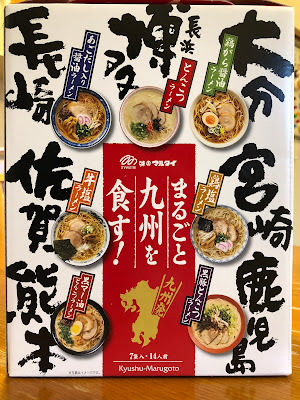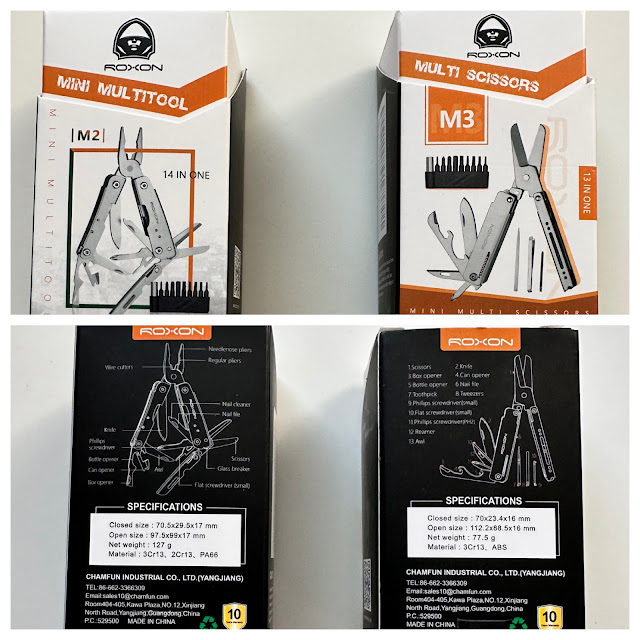I tried two kinds of Nissin UFO bowl noodles recently. One was a squid flavour from China, and the other was a salty pork noodle from Japan. Unlike your regular instant noodle bowl, UFO bowl noodles come in flattened bowls which look like the pie pan shaped UFOs of popular lore.
Nissin UFO Squid Noodles
If you wished for seafood, you'll get that in spades in this bowl of noodles. These noodles are from Nissin China and are part of their UFO line of noodle bowls. Nissin is a big company with many subsidiaries in many countries. Chinese versions of their products seem to be closer to Japanese tastes than in many other countries from my experience. The company does localize flavours, ingredients, and even the texture of the noodles.
 |
| Nice gold foil lid is clearly revealed after you peal off the plastic layer. Before, the bottom and side were coloured a pale blue from the plastic wrap. |
 |
| Another view. |
 |
| The ingredients and directions in Chinese. |
Once I peeled the foil lid to the plastic bowl back, a very pungent, fishy aroma wafted out. Pretty amazing considering that everything was sealed.
If you're used to these aromas, then you're going to find it tasty, if not, it
might be overwhelming.
 |
| There were 4 items inside the plastic bowl other than the noodles block. |
Inside the bowl where a teeny fork, a package of freeze dried vegetables, a small package of mayonnaise, and a generous package of the squid sauce.
- When you open the lid, you only open it half-way or a little less.
- Then you open up the package of dehydrated veggies and sprinkle them in.
- Now you pour in boiling water and let it sit for 3 minutes or so with the lid closed down.
- Then you peel back the foil lid a little bit on the opposite side that you opened. It will reveal an area that lets water drain out between some plastic tines built into the noodle bowl. This isn't as nice a method as the one on the Japanese version I'll review below as more veggies could flow out with the water. These UFO noodles are lo mein or just sauce with noodles and no soup.
- Once all the water is drained you open the sauce packet and squeeze the sauce on top. What I do is then close the lid again and shake the noodles around with the sauce to mix it up. I think it is easier than trying to stir.
- Now you can take the lid off completely and stir it some more. The mayonnaise can then be added now and the noodles are ready to eat.
 |
| Looks good, but the presentation is always a little messy with the mixing of the noodles with the sauce. |
These noodles were rounder in cross-section than the regular noodles from cup noodle and a little thinner, but I think they were denser and a little chewier. They were good noodles. The dried ingredients like carrot, green onion, and cabbage added some color to the dish. The flavour of the sauce was fishy with a squid flavour undertone. I enjoyed it but I think you need to be seafood fan for this. I know I wouldn't mind have this once in awhile, but not a one of my go to ramen.
Nissin UFO Salty Pork Noodle Bowl
This is an anniversary edition of a salty (shio) pork flavour instant ramen bowl. The Japanese packaging is usually fancier than the foreign editions of nissin noodles, but the price point is also higher in Japan. UFO bowl noodles are not a soup noodle, and they are a yakisoba style noodle where it is noodles mixed with sauce only.
 |
| Very attractive packaging, with the golden noodles showing on a brilliant dark blue background. The plastic wrap around the bowl is the branded packaging. |
 |
| Bottom of the bowl. You can see the wraparound packaging is done nicely all over. |
 |
| Once you peel off the packaging you have a very plain white noodle bowl and a foil lid that is very utilitarian. It is covered in directions and a packet of spices. |
 |
| A styrofoam bowl versus the plastic bowl in the noodle reviewed just above. |
 |
| There was just one sauce packet inside the bowl and the meat and veggies were already mixed in with the circular noodle block. |
Directions to make the noodles:
- THIS IS IMPORTANT. Open the lid half-way or a little less from the side opposite the black label.
- Now you pour in boiling water and let it sit for 3 minutes or so with the lid closed down.
- Peel back the black label on the opposite side that you
opened. It will reveal a drainage area with round holes in it. The holes let the water out, but not the noodles or freeze dried ingredients.
- Once all the water is
drained you open the sauce packet and squeeze the sauce on top. Close the lid again and shake the noodles around with the
sauce to mix it up. I think it is easier than trying to stir.
- Now
you can take the lid off completely and stir it some more. The noodles are now ready to eat.
 |
| Cool drain reveal |
 |
| The shaking scatters stuff around, but mixes the sauce and the noodles well. I then sprinkled the black and chili pepper spice mix on top for some added zip. |
These noodles were rounder and thinner than what was found in the regular cup noodles. I think these noodles have a chewier or firmer texture and they are pretty nice to eat. The sauce was relatively mild and I think there was a bit of garlic to it along with salt. The two kinds of black and chili peppers added a little heat to jazz up the flavour profile nicely. The dehydrated pork was in little sliced bits, not like the blocks of ground pork in the cup noodles. This was an interesting change (wish there was more pork), but it went nicely with the more generous amounts of cabbage (a fried yakisoba staple). Eating these noodles was no chore at all and I'm glad I have another one of these in the cupboard to enjoy a little later.
 |
| You can see the pork pieces and cabbage up close here. |
More Japanese pop culture and ramen posts
























Comments
Post a Comment